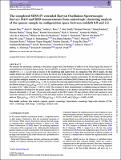Por favor, use este identificador para citar o enlazar a este item:
http://hdl.handle.net/10261/249679COMPARTIR / EXPORTAR:
 SHARE SHARE
 CORE
BASE CORE
BASE
|
|
| Visualizar otros formatos: MARC | Dublin Core | RDF | ORE | MODS | METS | DIDL | DATACITE | |

| Título: | The completed SDSS-IV extended Baryon Oscillation Spectroscopic Survey: BAO and RSD measurements from anisotropic clustering analysis of the quasar sample in configuration space between redshift 0.8 and 2.2 |
Autor: | Hou, Jiamin; Sánchez, Ariel G.; Ross, Ashley J.; Smith, Alex; Neveux, Richard; Burtin, Etienne; Zhao, Cheng; Scoccimarro, Román CSIC; Dawson, Kyle; Mattia, Arnaud de; Macorra, Axel de la; Bourboux, H.d.M.d.; Eisenstein, Daniel J.; Gil-Marín, Héctor CSIC; Lyke, Brad W.; Mohammad, Faizan G.; Mueller, Eva-Maria; Percival, Will J.; Rossi, Graziano; Vargas Magaña, Mariana; Zarrouk, Pauline; Zhao, Gong-Bo; Brinkmann, Jonathan; Brownstein, Joel R.; Chuang, Chia-Hsun; Myers, Adam D.; Newman, Jeffrey A.; Schneider, Donald P.; Vivek, Mariappan | Palabras clave: | Methods: data analysis Quasars: general Cosmology: observations Cosmology: dark energy Cosmology: distance scale |
Fecha de publicación: | 23-oct-2020 | Editor: | Oxford University Press | Citación: | Monthly Notices of the Royal Astronomical Society 500(1): 1201-1221 (2021) | Resumen: | We measure the anisotropic clustering of the quasar sample from Data Release 16 (DR16) of the Sloan Digital Sky Survey IV extended Baryon Oscillation Spectroscopic Survey (eBOSS). A sample of 343 708 spectroscopically confirmed quasars between redshift 0.8 < z < 2.2 are used as tracers of the underlying dark matter field. In comparison with DR14 sample, the final sample doubles the number of objects as well as the survey area. In this paper, we present the analysis in configuration space by measuring the two-point correlation function and decomposing it using the Legendre polynomials. For the full-shape analysis of the Legendre multipole moments, we measure the baryon acoustic oscillation (BAO) distance and the growth rate of the cosmic structure. At an effective redshift of zeff = 1.48, we measure the comoving angular diameter distance DM(zeff)/rdrag = 30.66 ± 0.88, the Hubble distance DH(zeff)/rdrag = 13.11 ± 0.52, and the product of the linear growth rate and the rms linear mass fluctuation on scales of $8 \, h{-1}\, {\rm Mpc}$, f?8(zeff) = 0.439 ± 0.048. The accuracy of these measurements is confirmed using an extensive set of mock simulations developed for the quasar sample. The uncertainties on the distance and growth rate measurements have been reduced substantially (?45 and ?30 per cent) with respect to the DR14 results. We also perform a BAO-only analysis to cross check the robustness of the methodology of the full-shape analysis. Combining our analysis with the Fourier-space analysis, we arrive at $D{{\bf c}}-{\rm M}(z-{\rm eff})/r-{\rm drag} = 30.21 \pm 0.79$, $D{{\bf c}}-{\rm H}(z-{\rm eff})/r-{\rm drag} = 13.23 \pm 0.47$, and $f\sigma-8{{\bf c}}(z-{\rm eff}) = 0.462 \pm 0.045$. | Versión del editor: | http://doi.org/10.1093/mnras/staa3234 | URI: | http://hdl.handle.net/10261/249679 | DOI: | 10.1093/mnras/staa3234 | Identificadores: | doi: 10.1093/mnras/staa3234 issn: 1365-2966 |
| Aparece en las colecciones: | (ICE) Artículos |
Ficheros en este ítem:
| Fichero | Descripción | Tamaño | Formato | |
|---|---|---|---|---|
| Completed_SDSS-IV_ext_BAO.pdf | 2,54 MB | Adobe PDF |  Visualizar/Abrir |
CORE Recommender
SCOPUSTM
Citations
143
checked on 11-may-2024
WEB OF SCIENCETM
Citations
114
checked on 26-feb-2024
Page view(s)
70
checked on 11-may-2024
Download(s)
43
checked on 11-may-2024
Google ScholarTM
Check
Altmetric
Altmetric
NOTA: Los ítems de Digital.CSIC están protegidos por copyright, con todos los derechos reservados, a menos que se indique lo contrario.
